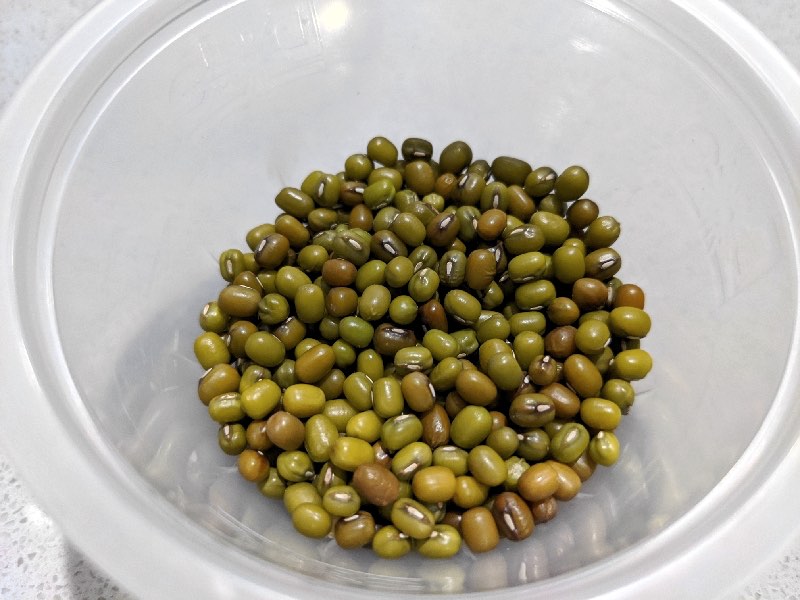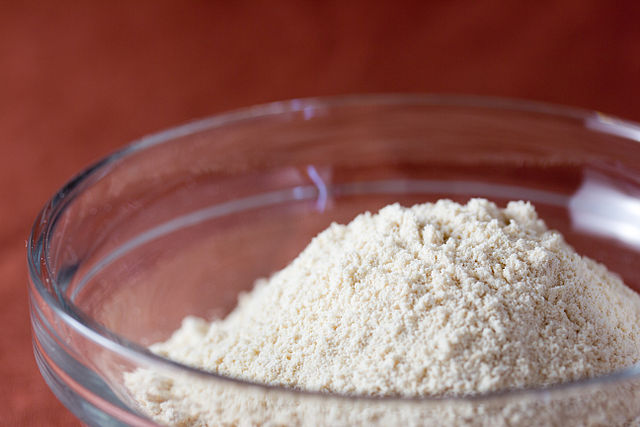Mung Bean vs. Soy Flour
Nutrition comparison of Mung Bean and Soy Flour
Ever wonder how your favorite foods stack up against each other in terms of nutrition?
We compared the nutritional contents of
mung bean
versus
soy flour
(100g each)
below using 2020 USDA and NIH data[1].
For a quick recap of significant nutrients and differences in mung bean and soy flour:
- Both soy flour and mung bean are high in calcium, calories, carbohydrates, dietary fiber, iron, potassium and protein.
- Soy flour has more Vitamin B6, however, mung bean contains more folate.
USDA sources for nutritional information: Mung Bean (Mung beans, mature seeds, raw) and Soy Flour (Soy flour, low-fat) . Have a correction or suggestions? Shoot us an email.
Calories and Carbs
calories
Both soy flour and mung bean are high in calories. Soy flour has a little more calories (7%) than mung bean by weight - soy flour has 372 calories per 100 grams and mung bean has 347 calories.
For macronutrient ratios, mung bean is much lighter in protein, much heavier in carbs and lighter in fat compared to soy flour per calorie. Mung bean has a macronutrient ratio of 27:70:3 and for soy flour, 50:31:20 for protein, carbohydrates and fat from calories.
Macro Ratios from Calories:
| Mung Bean | Soy Flour | |
|---|---|---|
| Protein | 27% | 50% |
| Carbohydrates | 70% | 31% |
| Fat | 3% | 20% |
| Alcohol | ~ | ~ |
carbohydrates
Both soy flour and mung bean are high in carbohydrates. Mung bean has 104% more carbohydrates than soy flour - soy flour has 30.6g of total carbs per 100 grams and mung bean has 62.6g of carbohydrates.
dietary fiber
Both soy flour and mung bean are high in dietary fiber. Soy flour is very similar to soy flour for dietary fiber - soy flour has 16g of dietary fiber per 100 grams and mung bean has 16.3g of dietary fiber.
sugar
Soy flour and mung bean contain similar amounts of sugar - soy flour has 9.3g of sugar per 100 grams and mung bean has 6.6g of sugar.
Protein
protein
Both soy flour and mung bean are high in protein. Soy flour has 109% more protein than mung bean - soy flour has 49.8g of protein per 100 grams and mung bean has 23.9g of protein.
Fat
saturated fat
Soy flour and mung bean contain similar amounts of saturated fat - soy flour has 1.3g of saturated fat per 100 grams and mung bean has 0.35g of saturated fat.
Vitamins
Vitamin C
Mung bean has more Vitamin C than soy flour - mung bean has 4.8mg of Vitamin C per 100 grams and soy flour does not contain significant amounts.
Vitamin A
Soy flour and mung bean contain similar amounts of Vitamin A - soy flour has 2ug of Vitamin A per 100 grams and mung bean has 6ug of Vitamin A.
Vitamin E
Soy flour and mung bean contain similar amounts of Vitamin E - soy flour has 0.55mg of Vitamin E per 100 grams and mung bean has 0.51mg of Vitamin E.
Vitamin K
Soy flour and mung bean contain similar amounts of Vitamin K - soy flour has 3.9ug of Vitamin K per 100 grams and mung bean has 9ug of Vitamin K.
The B Vitamins
Soy flour has more Vitamin B6, however, mung bean contains more folate. Both mung bean and soy flour contain significant amounts of thiamin, riboflavin, niacin and pantothenic acid.
| Mung Bean | Soy Flour | |
|---|---|---|
| Thiamin | 0.621 MG | 1.088 MG |
| Riboflavin | 0.233 MG | 0.28 MG |
| Niacin | 2.251 MG | 2.95 MG |
| Pantothenic acid | 1.91 MG | 1.55 MG |
| Vitamin B6 | 0.382 MG | 1.05 MG |
| Folate | 625 UG | 289 UG |
Minerals
calcium
Both soy flour and mung bean are high in calcium. Soy flour has 116% more calcium than mung bean - soy flour has 285mg of calcium per 100 grams and mung bean has 132mg of calcium.
iron
Both soy flour and mung bean are high in iron. Soy flour has 22% more iron than mung bean - soy flour has 8.2mg of iron per 100 grams and mung bean has 6.7mg of iron.
potassium
Both soy flour and mung bean are high in potassium. Soy flour has 109% more potassium than - soy flour has 2090mg of potassium per 100 grams and mung bean has 1246mg of potassium.
Antioxidants and Phytonutrients
Omega-3 and Omega-6
omega 3s
For omega-3 fatty acids, soy flour has more alpha linoleic acid (ALA) than mung bean per 100 grams.
| Mung Bean | Soy Flour | |
|---|---|---|
| alpha linoleic acid | 0.027 G | 0.555 G |
| Total | 0.027 G | 0.555 G |
omega 6s
Comparing omega-6 fatty acids, soy flour has more linoleic acid than mung bean per 100 grams.
| Mung Bean | Soy Flour | |
|---|---|---|
| linoleic acid | 0.357 G | 3.66 G |
| other omega 6 | ~ | 0.025 G |
| Total | 0.357 G | 3.685 G |
Customize your serving size
The comparison below is by weight, but sometimes 100g isn't that intuitive of a measurement for food. View a custom portion comparison (e.g. cups, oz, package).
You can try adding or subtracting the amount of either Mung Bean or Soy Flour .
Mung Bean g
()
|
Daily Values (%) |
Soy Flour g
()
|
|||||
|---|---|---|---|---|---|---|---|
| KCAL % |
|
5% | calories | 5% |
|
KCAL % | |
| G % |
|
5% | carbohydrates | 5% |
|
G % | |
| G % |
|
5% | dietary fiber | 5% |
|
G % | |
| G | 5% | sugar | 5% | G | |||
| G % |
|
5% | total fat | 5% |
|
G % | |
| G % |
|
5% | saturated fat | 5% |
|
G % | |
| G | 5% | monounsaturated fat | 5% | G | |||
| G | 5% | polyunsaturated fat | 5% | G | |||
| G | 5% | trans fat | 5% | G | |||
| MG | 5% | cholesterol | 5% | MG | |||
| MG % |
|
5% | sodium | 5% |
|
MG % | |
| 5% | Vitamins and Minerals | 5% | |||||
| UG % |
|
5% | Vitamin A | 5% |
|
UG % | |
| MG % |
|
5% | Vitamin C | 5% |
|
MG % | |
| IU % |
|
5% | Vitamin D | 5% |
|
IU % | |
| MG % |
|
5% | calcium | 5% |
|
MG % | |
| MG % |
|
5% | iron | 5% |
|
MG % | |
| MG % |
|
5% | magnesium | 5% |
|
MG % | |
| MG % |
|
5% | potassium | 5% |
|
MG % | |
| MG % |
|
5% | thiamin (Vit B1) | 5% |
|
MG % | |
| MG % |
|
5% | riboflavin (Vit B2) | 5% |
|
MG % | |
| MG % |
|
5% | niacin (Vit B3) | 5% |
|
MG % | |
| MG % |
|
5% | Vitamin B6 | 5% |
|
MG % | |
| MG % |
|
5% | pantothenic acid (Vit B5) | 5% |
|
MG % | |
| UG % |
|
5% | folate (Vit B9) | 5% |
|
UG % | |
| UG % |
|
5% | Vitamin B12 | 5% |
|
UG % | |
| MG % |
|
5% | Vitamin E | 5% |
|
MG % | |
| UG % |
|
5% | Vitamin K | 5% |
|
UG % | |
| G % |
|
5% | protein | 5% |
|
G % | |
| UG % |
|
5% | biotin (Vit B7) | 5% |
|
UG % | |
| MG % |
|
5% | choline | 5% |
|
MG % | |
| MG % |
|
5% | chlorine | 5% |
|
MG % | |
| UG % |
|
5% | chromium | 5% |
|
UG % | |
| MG % |
|
5% | copper | 5% |
|
MG % | |
| UG % |
|
5% | fluoride | 5% |
|
UG % | |
| UG % |
|
5% | iodine | 5% |
|
UG % | |
| MG % |
|
5% | manganese | 5% |
|
MG % | |
| UG % |
|
5% | molybdenum | 5% |
|
UG % | |
| MG % |
|
5% | phosphorus | 5% |
|
MG % | |
| UG % |
|
5% | selenium | 5% |
|
UG % | |
| MG % |
|
5% | zinc | 5% |
|
MG % | |
| G | 5% | Water | 5% | G | |||
| G | 5% | Starch | 5% | G | |||
| G | 5% | Alcohol | 5% | G | |||
FAQ
Does soy flour or mung bean contain more calories in 100 grams?Both soy flour and mung bean are high in calories. Soy flour has a little more calories ( 10%) than mung bean by weight - soy flour has 372 calories in 100g and mung bean has 347 calories.
Is soy flour or mung bean better for protein?
Both soy flour and mung bean are high in protein. Soy flour has 110% more protein than mung bean - soy flour has 49.8g of protein per 100 grams and mung bean has 23.9g of protein.
Does soy flour or mung bean have more carbohydrates?
By weight, both soy flour and mung bean are high in carbohydrates. mung bean has 100% more carbohydrates than soy flour - soy flour has 30.6g of carbs for 100g and mung bean has 62.6g of carbohydrates.
Does soy flour or mung bean contain more calcium?
Both soy flour and mung bean are high in calcium. Soy flour has 120% more calcium than mung bean - soy flour has 285mg of calcium in 100 grams and mung bean has 132mg of calcium.
Does soy flour or mung bean contain more iron?
Both soy flour and mung bean are high in iron. Soy flour has 20% more iron than mung bean - soy flour has 8.2mg of iron in 100 grams and mung bean has 6.7mg of iron.
Does soy flour or mung bean contain more potassium?
Both soy flour and mung bean are high in potassium. Soy flour has 110% more potassium than - soy flour has 2090mg of potassium in 100 grams and mung bean has 1246mg of potassium.

